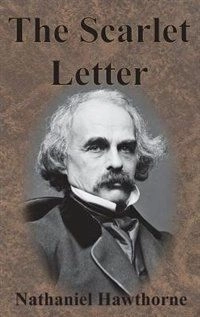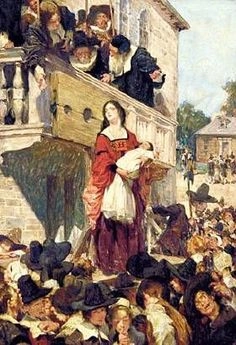The Scarlet Letter by Nathaniel Hawthorne deals with the consequences of sin and societal judgment in the 17th-century Puritanical Massachusetts Bay Colony through the story of Hester Prynne’s public shame for adultery.

Facts About “The Scarlet Letter”
| Facts | Description |
| Author | Nathaniel Hawthorne |
| Genre | Novel |
| Setting | 17th-century Puritanical Massachusetts Bay Colony |
| Main Characters | Hester Prynne, Arthur Dimmesdale, Roger Chillingworth, and Pearl |
Summary Of The Scarlet Letter
“The Scarlet Letter,” a famous book by Nathaniel Hawthorne, takes us back to a time when things were drastically different from what they are today.
It takes place in the Massachusetts Bay Colony in the seventeenth century. This is no ordinary colony; instead, it is a place where religious views are held in the highest regard, and disobeying the regulations might get you into serious trouble.

Let’s begin the story now. Imagine Hester Prynne, a lady, finding herself in a serious bind. During those days, she was found committing a major transgression: adultery. That was not only unacceptable back then; it was a huge scandal.
Hester is therefore sentenced to wear a large, strong letter “A” on her clothing as a sign of “adultery,” so “The Scarlet Letter,” a famous book by Nathaniel Hawthorne, takes us back to a time when things were drastically different from what they are today.
It takes place in the Massachusetts Bay Colony in the seventeenth century. This is no ordinary colony; instead, it is a place where religious views are held in the highest regard, and disobeying the regulations might get you into serious trouble.
Let’s begin the story now. Imagine Hester Prynne, a lady, finding herself in a serious bind. During those days, she was found committing a major transgression: adultery. That was not only unacceptable back then; it was a huge scandal.

Hester is therefore sentenced to wear a large, strong letter “A” on her clothing as a sign of “adultery,” so “The Scarlet Letter,” a famous book by Nathaniel Hawthorne, takes us back to a time when things were drastically different from what they are today.
It takes place in the Massachusetts Bay Colony in the seventeenth century. This is no ordinary colony; instead, it is a place where religious views are held in the highest regard, and disobeying the regulations might get you into serious trouble.
Let’s begin the story now. Imagine Hester Prynne, a lady, finding herself in a serious bind. During those days, she was found committing a major transgression: adultery. That was not only unacceptable back then; it was a huge scandal.
Hester is therefore sentenced to wear a large, strong letter “A” on her clothing as a sign of “adultery,” so everyone knows what she’s done.
The problem is that Hester will not reveal the identity of the father. She doesn’t disclose it, despite the fact that doing so puts her in the crosshairs of her community.
Let’s now discuss the other main characters in this drama. The local clergyman, Arthur Dimmesdale, is one of them.
He too has a secret: he’s the father! But, you guessed it—he’s too afraid to say it because he’s concerned about what people will think.
And then there’s Hester’s husband, Roger Chillingworth. He knows something is wrong, though he’s not sure what it is, which is why he’s out for revenge.
There are several dramatic moments in the story as a result of his quest to discover the truth.
Not to be overlooked is Pearl, Hester’s daughter. She’s a stubborn little child who serves as a continual reminder of her mother’s error as well as a beacon of hope and atonement.

These characters struggle with shame, guilt, and the burden of social expectations as the narrative progresses.
There are lies, secrets, and heartbreaking moments. However, there are also glimmers of hope for forgiveness and fresh starts.
Ultimately, “The Scarlet Letter” is a tale of the human condition, our ability to forgive, and the strength of love to overcome even the most terrible secrets—it’s not just the narrative of a lady who committed a mistake.
Analysis Of “The Scarlet Letter”
“The Scarlet Letter” by Nathaniel Hawthorne is a gripping exploration of the moral climate of the Puritanical Massachusetts Bay Colony in the seventeenth century.
Under its superficial storyline, there is a deep examination of human character, societal evaluation, and the intricacies of sin and salvation.
“The Scarlet Letter” primarily addresses the fallout from adultery and the stigma associated with it in society.
Hawthorne examines the tenacious strength of perseverance and the pursuit of atonement in the face of social disgrace through the figure of Hester Prynne.
Hester defies the strict moral standards of her society and epitomizes bravery and resistance despite the weight of her scarlet letter “A.”
The town’s famous clergyman, Arthur Dimmesdale, is grappling with the consequences of his own deeds, and his tormented inner conflict serves as a devastating reminder of the deadly ramifications of guilt and secrecy.
Hawthorne uses strong symbolism to express deeper meanings and ideas across the entire book.
As a constant reminder of Hester’s sin and her reluctance to let it define her, the scarlet letter itself takes on a significant symbolic meaning that combines resistance and humiliation.
Likewise, as characters face their transgressions and strive for forgiveness, the scaffold functions as a recurrent motif, signifying both public judgment and private salvation.
The ageless ideas, complex symbolism, and vibrant characters in “The Scarlet Letter” enthrall readers with their profound examination of the human condition and the universal desire for understanding.

Characters of The Scarlet Letter
Hester Prynne
Hester Prynne, the protagonist of the book, is a representation of perseverance in the face of hardship. Hester, who was marked with the red letter “A” for her adultery, defies social norms and refuses to be defined by them.
Rather, she turns into a ray of strength, embracing who she is and discovering meaning in raising Pearl, her daughter.
Hester’s path serves as a testament to the transformational power of love and forgiveness throughout the narrative.
Arthur Dimmesdale
The respected minister of the community, Arthur Dimmesdale, is battling an internal battle that could destroy him. Overwhelming guilt and shame plague Dimmesdale because he is the child’s secret father.
He struggles with the weight of his transgression throughout the book, caught between the burden of his private transgression and his public image as a shining example of morality.
The devastating examination of the effects of moral deceit and the pursuit of redemption is provided by Dimmesdale’s character.
Roger Chillingworth
Roger Chillingworth represents the deadly power of vengeance, in contrast to Hester’s fortitude and Dimmesdale’s internal strife.
Chillingworth, Hester’s estranged husband, is driven by a need for vengeance. And becomes obsessed with finding out who her lover is.
His unrelenting quest for vengeance sends him down a dark and evil path, acting as a terrifying reminder of the destructive power of unresolved resentment and rage.
Pearl
Hester’s daughter, Pearl, appears in the story as a figure of both innocence and rebellion. Pearl was born out of wedlock and is a living reminder of her mother’s transgressions. Yet she also has an inborn energy and enthusiasm that surpass social norms.
Pearl’s presence acts as a catalyst for transformation throughout the book, upending the strict moral standards of her Puritanical society and finally guiding Hester and Dimmesdale toward forgiveness.

Themes In The Scarlet Letter
| Major Theme | Description |
| Sin | The novel explores the consequences of sin, particularly adultery, and its impact on individuals |
| Guilt | Characters grapple with overwhelming feelings of guilt and remorse for their transgressions |
| Redemption | Despite the weight of their sins, characters seek redemption and strive for moral renewal |
| Societal Judgment | The harsh judgment and condemnation of society play a significant role in shaping characters’ lives |
| Hypocrisy | The novel critiques the hypocrisy of outwardly pious characters who conceal their own sins |
Allusions
“The Scarlet Letter” contains biblical allusions, particularly to the story of Adam and Eve and the concept of original sin.
The novel also alludes to historical events such as the Salem witch trials and the colonization of America by Puritans.
Critical Response
Critics first had conflicting opinions on “The Scarlet Letter,” with some denouncing its alleged depravity and others applauding its literary value.
But as time went on, the book grew in popularity and is now regarded as a masterpiece of American literature.
Hawthorne’s portrayal of Puritan society, along with his examination of issues like sin, shame, and salvation, has garnered accolades from critics.
Symbolism In The Scarlet Letter
| Symbol | Description |
| The Scarlet Letter | Represents sin, guilt, and societal judgment. It is a visible reminder of Hester Prynne’s adultery. |
| The Scaffold | Symbolizes public judgment and personal redemption. It is where characters face the consequences of their actions. |
| Pearl | Symbolizes both the consequences of sin and the possibility of redemption. Pearl is Hester’s daughter, born out of adultery. |
| The Forest | Represents a place of freedom and escape from societal constraints. It is where characters find solace and renewal. |
| Sunlight vs. Shadows | Symbolizes the contrast between truth and secrecy, light and darkness, throughout the novel. |
Conclusion
“The Scarlet Letter” uses powerful symbols like the scarlet letter, the scaffold, and Pearl to intricately weave a narrative. Furthermore, it explores the complexities of sin, guilt, and redemption within the confines of Puritan society.
FAQs
The Scarlet Letter” is about a woman, Hester Prynne, who is punished for committing adultery and forced to wear the scarlet letter “A” on her clothing as a mark of shame.
The main idea of “The Scarlet Letter” is the impact of guilt and sin on individuals and society.
The point of “The Scarlet Letter” is to explore the complexities of morality, sin, and redemption.
“The Scarlet Letter” was banned for its perceived immorality and explicit content.
“The Scarlet Letter” is often considered a feminist novel for its portrayal of a strong female protagonist who challenges societal norms and expectations.
Related Posts
Oswald In King Lear | Character Analysis & Quotes
Eddie Crazy Rich Asians As An Actor, Net Worth & Early life
Analysis Of First Player’s Speech In Hamlet | By Shakespeare
Lady Macbeth Monologue | In Macbeth By Shakespeare
11 Important Themes Of Pygmalion & Symbolism| By Bernard Shaw









